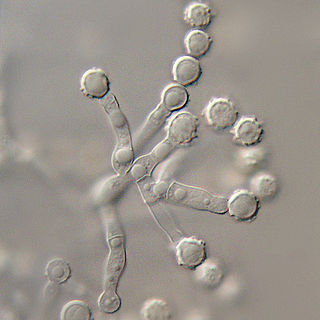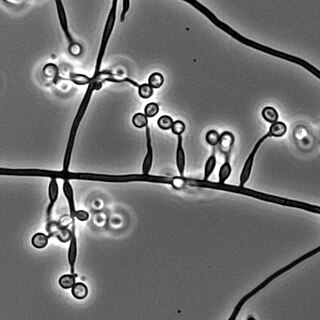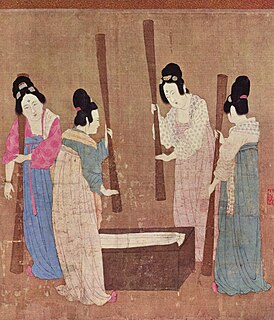
Plant pathology is the scientific study of diseases in plants caused by pathogens and environmental conditions. Organisms that cause infectious disease include fungi, oomycetes, bacteria, viruses, viroids, virus-like organisms, phytoplasmas, protozoa, nematodes and parasitic plants. Not included are ectoparasites like insects, mites, vertebrate, or other pests that affect plant health by eating of plant tissues. Plant pathology also involves the study of pathogen identification, disease etiology, disease cycles, economic impact, plant disease epidemiology, plant disease resistance, how plant diseases affect humans and animals, pathosystem genetics, and management of plant diseases.

Aspergillus flavus is a saprotrophic and pathogenic fungus with a cosmopolitan distribution. It is best known for its colonization of cereal grains, legumes, and tree nuts. Postharvest rot typically develops during harvest, storage, and/or transit. A. flavus infections can occur while hosts are still in the field (preharvest), but often show no symptoms (dormancy) until postharvest storage and/or transport. In addition to causing preharvest and postharvest infections, many strains produce significant quantities of toxic compounds known as mycotoxins, which, when consumed, are toxic to mammals. A. flavus is also an opportunistic human and animal pathogen, causing aspergillosis in immunocompromised individuals.

Candida is a genus of yeasts and is the most common cause of fungal infections worldwide. Many species are harmless commensals or endosymbionts of hosts including humans; however, when mucosal barriers are disrupted or the immune system is compromised they can invade and cause disease, known as an opportunistic infection. Candida is located on most of mucosal surfaces and mainly the gastrointestinal tract, along with the skin. Candida albicans is the most commonly isolated species and can cause infections in humans and other animals. In winemaking, some species of Candida can potentially spoil wines.

Beauveria bassiana is a fungus that grows naturally in soils throughout the world and acts as a parasite on various arthropod species, causing white muscardine disease; it thus belongs to the entomopathogenic fungi. It is being used as a biological insecticide to control a number of pests such as termites, thrips, whiteflies, aphids and different beetles. Its use in the control of bedbugs and malaria-transmitting mosquitos is under investigation.

Dermatophytosis, also known as ringworm, is a fungal infection of the skin. Typically it results in a red, itchy, scaly, circular rash. Hair loss may occur in the area affected. Symptoms begin four to fourteen days after exposure. Multiple areas can be affected at a given time.

An entomopathogenic fungus is a fungus that can act as a parasite of insects and kills or seriously disables them.

Metarhizium anisopliae, formerly known as Entomophthora anisopliae (basionym), is a fungus that grows naturally in soils throughout the world and causes disease in various insects by acting as a parasitoid. Ilya I. Mechnikov named it after the insect species from which it was originally isolated - the beetle Anisoplia austriaca. It is a mitosporic fungus with asexual reproduction, which was formerly classified in the form class Hyphomycetes of the phylum Deuteromycota. According to Paul Stamets, it could be the answer to prevent colony collapse disorder and catastrophic famine.

The Clavicipitaceae are a family of fungi within the order Hypocreales. A 2008 estimate placed 43 genera in the family, but recent work has increased this number to 97.
Hyphomycetes are a form classification of Fungi, part of what has often been referred to as Fungi imperfecti, Deuteromycota, or anamorphic fungi. Hyphomycetes lack closed fruit bodies, and are often referred to as moulds. Most hyphomycetes are now assigned to the Ascomycota, on the basis of genetic connections made by life-cycle studies or by phylogenetic analysis of DNA sequences; many remain unassigned phylogenetically. Identification of hyphomycetes is primarily based on microscopic morphology including: conidial morphology, especially septation, shape, size, colour and cell wall texture, the arrangement of conidia as they are borne on the conidiogenous cells, the type conidiogenous cell, and other additional features such as the presence of sporodochia or synnemata.

Fusarium solani is a species complex of at least 26 closely related filamentous fungi in the division Ascomycota, family Nectriaceae. It is the anamorph of Nectria haematococca. It is a common soil fungus and colonist of plant materials. Fusarium solani is implicated in plant disease as well as human disease notably infection of the cornea of the eye.

In epidemiology, a disease vector is any agent which carries and transmits an infectious pathogen into another living organism; most agents regarded as vectors are organisms, such as intermediate parasites or microbes, but it could be an inanimate medium of infection such as dust particles.

Metarhizium acridum is the new name given to a group of fungal isolates that are known to be virulent and specific to the Acrididea. Previously, this species has had variety status in Metarhizium anisopliae ; before that, reference had been made to M. flavoviride or Metarhizium sp. describing an "apparently homologous and distinctive group" of isolates that were most virulent against Schistocerca gregaria in early screening bioassays.

Metarhizium flavoviride is the name given to a group of fungal isolates that are known to be virulent against Hemiptera and some Coleoptera. Spores (conidia) are light grey-green and oval-shaped.
In biology, a pathogen in the oldest and broadest sense, is anything that can produce disease. A pathogen may also be referred to as an infectious agent, or simply a germ.

Muscardine is a disease of insects. It is caused by many species of entomopathogenic fungus. Many muscardines are known for affecting silkworms. Muscardine may also be called calcino.

Microascus brevicaulis is a microfungus in the Ascomycota. Most of the discussion of this fungus in the scientific and medical literature has referred to the fungus using the name of its asexual form, or anamorph, Scopulariopsis brevicaulis. However, a sexual form (teleomorph) named Microascus brevicaulis was recently described. Under the current revision of International Code of Nomenclature for Algae, Fungi, and Plants, as articulated in the Melbourne Code, it remains unclear which name this fungus will ultimately take. Until further clarification, Microascus brevicaulis is considered the most recent, accepted name. Microascus brevicaulis occurs world-wide as a saprotroph in soil, a common agent of biodeterioration, an irregular plant pathogen, and an occasional agent of human nail infection. Bartolomeo Gosio discovered in 1890 that under wet conditions M. brevicaulis produces significant amounts of trimethylarsine via biomethylation of inorganic pigments especially Paris green or Scheele's Green used in indoor wallpapers which is then released into the air.

Human interactions with fungi include both beneficial uses, whether practical or symbolic, and harmful interactions such as when fungi damage crops, timber, or food.

Metarhizium granulomatis is a fungus in the family Clavicipitaceae associated with systemic mycosis in veiled chameleons. The genus Metarhizium is known to infect arthropods, and collectively are referred to green-spored asexual pathogenic fungi. This species grows near the roots of plants and has been reported as an agent of disease in captive veiled chameleons. The etymology of the species epithet, "granulomatis" refers to the ability of the fungus to cause granulomatous disease in susceptible reptiles.














